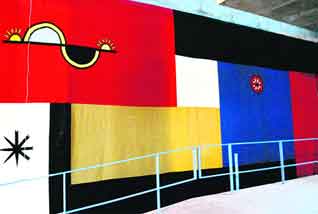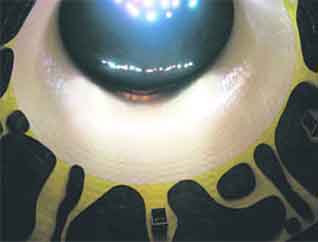Architecture
Primary Colours:
The Punjab Capital & Capitol
RAJNISH WATTAS
Man needs colour to live; it is just as necessary an element as water or fire -- Fernand Leger
If Robert Langdon, the professor of symbology in the fiction bestseller and Hollywood blockbuster, “Da Vinci Code“, was to visit Punjab’s capital city, Chandigarh, and its Capitol complex, he would have plenty of work. He would be kept busy decoding Chandigarh's "crowning glory," replete with enigmatic monuments, bas-reliefs, colours, symbols and cryptic signs.
The Capitol, comprising the key pivotal buildings: the Secretariat, the Assembly, the High Court -- and the unbuilt Governor's Palace/Museum of Knowledge are visually connected by a large number of "monuments" like the Open Hand, Martyr's Memorial, Geometric Hill, Tower of Shades, 24 Solar Hours and the Course of Sun between Solstices.
In fact, Corbusier, the city’s French architect, realized that the vast piazza between the two primary buildings, the Assembly and the High Court, needed to be articulated with a play of forms, splashes of bright colours, signs, dapples of light and shadows and mirror images in water basins.
Thus, at the Capitol, art and architecture come together as one unified conception, each complementing the other. This is not surprising, for Corbusier was like a latter-day 20th century's Leonardo da Vinci and not only merely an architect-urbanist. He was a painter, sculptor, writer, philosopher and a poet too.
Another dimension of the Capitol is to relate it to the pristine beauty of nature and its vibrant colours and the resplendent view of the lower Himalayan hills on the horizon. The ensemble of the edifices and monuments engage in an occult interplay of landscape, skylines, silhouettes and pedestrian esplanades, connecting to one another.
COLOURS & CONCRETE
The building material chosen for the Capitol buildings was concrete, as it was locally available, it was familiar to local builders and had the raw, brute aesthetic appeal that Corbusier called, "molten rock of the twentieth century". He wanted to convey its truthful ruggedness through exposed surfaces with shuttering patterns, bas-reliefs and motifs.
The motif designs range from Harappan seals, pastoral animals like bulls, cows and replicas of birds, fish often etched out by village labourers on wet concrete surfaces. It is these that fascinated Corbusier.
But it's his use of bold, primary colours both on the external facades and in the interiors of the buildings that is most striking, such as painting the 60-feet-high majestic High Court pylons.
The box-like volume of the building is marked by the arcades of its parasol roof vaulting over the court rooms: both to give protection from the hot summer sun and symbolise the rule of law and justice that protects the citizen.
Kenneth Frampton connects this design to the astronomical observatories at Delh and Jaipur, and the arches of the Diwan-i-am with the parabolic arches of the Punjab High Court. Similarly, the soaring pylons echo the grandiose scale of the Buland Darwaza at Fatehpur Sikri.
To create a strong visual counter-balance to the sculptural Assembly's hyperbolic paraboloid dome, he chose to paint the three pylons with pastel shades of green, yellow and pink salmon. These contrast powerfully with the grey tones of the rough textured concrete facade. Since the pylons had initially been painted in white, the judges accustomed to Acropolis-like sanctity were at first appalled, but gradually saw the logic and beauty behind the change.
The use of a bold palette of colours is based on a theory developed by Corbusier over the years. He called this scale of colour harmonies as Polycromie architecturale, with colour keyboards as an analogy to musical harmonies.
"These colours bear a strong relation to Nature; and secondly introduce a new kind of colour link between inside and outside, using colour as a space-defining element," says Giuseppina Scavuzzo.
TAPESTRIES
As one enters the Punjab Assembly, the hyperbolic paraboloid, vertically soaring hall (inspired by the cooling towers of power houses seen on way to Ahmedabad) -- bright colours hit the eye as a high-voltage sensory experience.
There are three bands of colours on the inside concave curving walls -- the first covered with sound-absorbing acoustic tiles over a red painted wall. The second ring is painted in pastel yellow, and as the eye moves upwards there are cloud-like shapes floating over the narrowing diameter of the dome, culminating into the skylight. The floor is also covered with yellow carpet over which are fixed green upholstered chairs, especially designed by the Corbusier team.
Besides the wall colours, the tapestries designed by Corbusier for the Courts and the Assembly lounge areas are remarkable pieces of "wall paintings in wool".
There are nine large tapestries in the High Court and three in the Assembly. Common to their themes are the rectangular patches of colours in the background, adopted from Corbusier's Polycromie architecturale, adorned with quizzical symbols of rivers, trees, reptiles, lightening, balance and inter-play of opposing forces in life.
The sizes range from 64 to 144 sq m in the High Court and from 135 to 155 sq m in the Assembly building. Corbusier called his tapestries, "nomadic murals," as one could carry them to new destinations. He was also inspired by the durree-weaving traditions of Punjab, and hoped that the village crafts-persons would weave them in parts to be sewn together, an idea which didn’t mature because they were ultimately made by a carpet company.
The initial reactions of some judges to these unfamiliar abstract designs were negative, and one even exclaimed, "For God's sake, burn them or do some thing", records Norma Evenson. Eventually things settled down and today they are a precious heritage of the Court.
Chandigarh is replete with the mystique of its architect-planner talking to the people of the City through signs, messages, art and edicts embedded in his buildings -- akin to the tablets, cryptic symbols and signs of ancient civilisations at historic sites.
These remain unfortunately unappreciated and shrouded in mystique and enigmas. The forbidding barbed-wire security ring around the Capitol precincts, keeping out the very citizen for whom the citadels of democracy these were meant, is the City's loss.
Hopefully, with some recent initiatives by the Chandigarh Administration, the Punjabi citizen will reclaim his rightful territory.
PAINTING ON ASSEMBLY DOOR
Le Corbusier wanted to gift an enamelled door painted by him personally for the Assembly, depicting symbols - not of ancient India but those of the new nation. He asked for "symbolic signs" that could be represented; in turn, it was suggested to him that Corbusier, being a futurist, could perhaps invent them.
The nearly 25 feet square door is pivoted in the middle of the Assembly portico, facing the High Court, to be opened exclusively on ceremonial days.
The outer face, as a strong visual counterpoint to the vibrant colours of the High Court pylons, is divided into two equal parts. The upper part is a landscape with the red and yellow sky above depicting the solar and the lunar cycles, the solstices, and the equinoxes manifesting Corbusier's preoccupation with man's relationship with the cosmos.
The lower half is populated with animals, natural formations, and other cryptic symbols distributed evenly over the entire surface. The background of the desert depicts the original order on earth and the green, symbolises the "Garden of Eden" landscape.
Amidst the greenery stands Corbusier's abstracted human figure, the upright Modular Man. A river meanders on the left and as an abstracted ecosystem, there is a turtle, a bull, a fish, and, of course, the serpent. In the centre is the proverbial "Tree of Knowledge" flowering into the fruits of knowledge.
The door was installed in the Assembly building, and Le Corbusier specifically came to attend its dedication ceremony on April 15, 1964, barely a year before his death.
[The author is former Principal of the Chandigarh College of Architecture, and co-author of “Trees of Chandigarh and Sukhna -- Sublime Lake of Chandigarh.”]
[Courtesy: Tribune. Edited for sikhchic.com]
June 14, 2013
Conversation about this article
1: Harinder (Uttar Pradesh, India), June 14, 2013, 12:25 PM.
Punjab and its capital must reflect the cosmic beauty we live in. It must also reflect the colours of unseen "parallel universes" on which our children shall walk one day.






